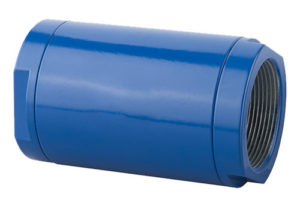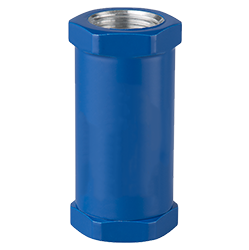
Although pneumatic systems operate at much lower pressures than hydraulic ones, ISO and OSHA standards are firm about the need to prevent whiplash hazards, in case a compressed air hose breaks lose from its couplings. These hoses must be restrained or shielded from workers and machines—or designed with airfuses to automatically turn off if a break occurs.
A common method of protecting against hose whip in most fluid power systems is to use some sort of hose restraint system, which prevents a hose from whipping around after breaking loose from its fittings. These devices can be as simple as a clamp and cable, which secure the hose to the machine. However, another option is available to protect against pneumatic hose whip if a compressed air hose or pipe should break.
Airfuse protection, such as the HoseGuard from ProportionAir or AirGuard from Parker Hannifin, immediately shuts off air supply if the volume of air exceeds a set value due to broken pipes or hoses. These devices protect personnel and plant machinery from pneumatic hose whip by reducing pressure when a hose ruptures or accidentally comes loose from its coupling. This eliminates the dangerous occurrence of pneumatic hose whip.

The system features a factory preset value to allow normal air consumption when using air tools. If the air consumption exceeds this preset value, an internal piston instantly shuts off the main flow. Then, an integral bleed hole allows some air to flow through. This enables the line pressure to automatically reset the airfuse device once the main break is repaired.
The function of these devices is simple. Compressed air passes through the inlet of the airfuse, and as it passes the piston, it is slowed down by lengthwise grooves on the outer side of the piston. Air cannot pass the piston if flow is too high, so the piston is forced against the spring and to the seat. A bleed hole allows the airfuse device to reset and open after the hose is repaired.
When selecting an airfuse device, you must know the internal diameter of the hose, pipe or tube, as well as its length. Application data is also required when selecting the material, as they are available in aluminum, stainless steel, Nitrile rubber, and plastic, among others.
A key benefit to these devices is that they allow personnel to safely maintain and repair the hose system while the plant is still operational.
Proportion-Air Inc.
proportionair.com
Parker Hannifin Corp.
parker.com

Leave a Reply